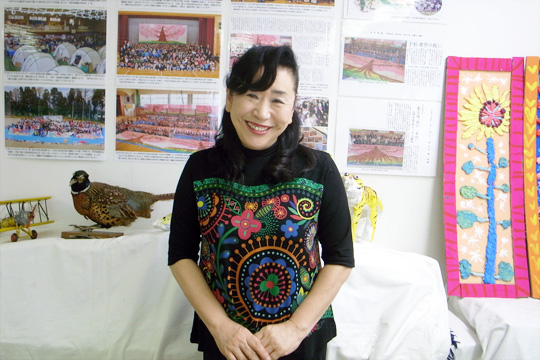
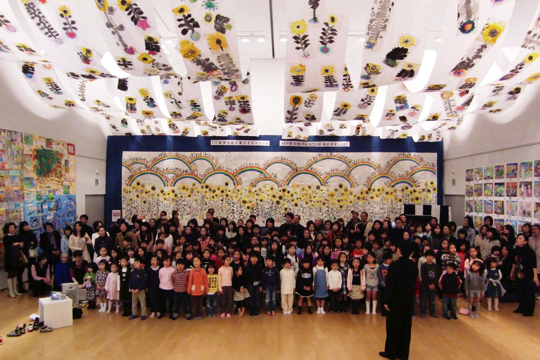 Photo: Scene from the Disaster Prevention Art Exhibition. The exhibition commemorating the 15th anniversary of the 1995 Great Hanshin-Awaji Earthquake included displays at the Hyogo Prefectural Museum of Art, and a chorus performance of Bring Happiness to the World, conducted by Makoto Usui (the elementary-school music teacher who wrote the music and lyrics) in front of sunflower drawings embodying the prayers of the artists who made them.
Photo: Scene from the Disaster Prevention Art Exhibition. The exhibition commemorating the 15th anniversary of the 1995 Great Hanshin-Awaji Earthquake included displays at the Hyogo Prefectural Museum of Art, and a chorus performance of Bring Happiness to the World, conducted by Makoto Usui (the elementary-school music teacher who wrote the music and lyrics) in front of sunflower drawings embodying the prayers of the artists who made them.
Painter Yoko Nakajima hosts “Inochi no Jugyo” (lit. life lessons), which are art classes designed to convey the preciousness of life through picture-making. Driven by a desire to preserve memories of earthquakes, she has involved herself in a range of art-mediated disaster mitigation activities. Following the 2011 Tohoku earthquake and tsunami (Great East Japan Earthquake), she has visited affected localities every six months to support the emotional wellbeing of local children.
I believe in the power and potential of art. Imagining what it would be like to be at the scene of an earthquake gives tremendous force to a painting. Earthquakes provide children with rare opportunities to think deeply about life.
Ten years lost in grief
The 1995 Great Hanshin-Awaji Earthquake completely destroyed the apartment room where Ms. Nakajima had been storing her art materials and works. Her home and studio also suffered considerable structural damage. What affected her most, however, was the death of two very close students of her art classes, and their families. She spent day after day in tears. Since reopening her art classes, Ms. Nakajima and her art class students have prayed before January 17 every year for the souls of the 6,434 earthquake victims.
A turning point came in the tenth year after the earthquake, in the form of an announcement addressed to art class students calling for entries to the 20th Disaster Prevention Poster Competition hosted by the Cabinet Office. Reproduced on the announcement was a poster bearing the words “Oh! Earthquake!” which struck Ms. Nakajima with an idea.
I realized that earthquake awareness can be communicated through pictures. Making posters saying “Prepare a bug-out bag!” or “Earthquakes are followed by a tsunami,” for instance, can contribute to disaster mitigation, and doing so is a challenge for art worth tackling.
Together with her art class students, Ms. Nakajima started to submit works to competitions such as the Disaster Prevention Poster Competition, National Disaster Prevention Competition for Children, and Competition of Disaster Prevention Education Programs.
Life was dear to everyone who died
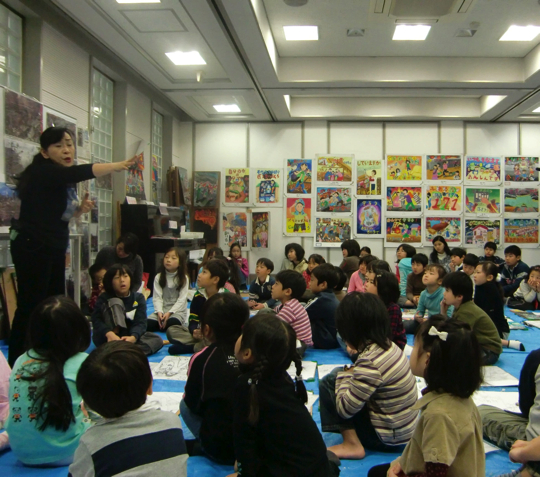
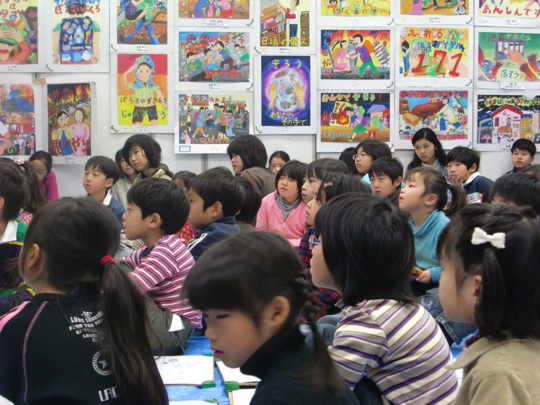 Photo: Scene from one of the “Disaster drawing” sessions devoted to making pictures inspired by earthquakes, held annually at Ms. Nakajima’s art classes
Photo: Scene from one of the “Disaster drawing” sessions devoted to making pictures inspired by earthquakes, held annually at Ms. Nakajima’s art classes
After the funeral of one of her art class students, a bereaved family member spoke to the distressed Ms. Nakajima: “When the family was found, the husband was shielding his wife, who was in turn lying over her children and baby as if she had been trying to protect them. In the arms of their parents, the children looked utterly angelic and unharmed.”
By communicating how parents tried to save their children at the expense of their own lives, I wanted to send home to children the importance of living each moment of life to the fullest, and appreciating the fact that they are alive now.
To this end, each year Ms. Nakajima offers “Shinsai Inochi no Jugyo” (lit. Post-earthquake life lessons), a series of classes where participants ranging in age from kindergarten to high school create paintings themed around earthquakes. Participants are shown footage of the Great Hanshin-Awaji Earthquake, and listen to contemporary accounts, which Ms. Nakajima provides in a passionate, engaging talk.
The violent tremor; the fire engulfing Nagata Ward; a mother trapped beneath a fallen house screaming to her child to flee without her amid the approaching flames. . .
In the classroom, which typically turns deadly silent, children close their eyes, “ingest” the images they have just seen, and start working on pictures that capture an earthquake, the likes of which they have never experienced themselves.
Adults should make greater efforts to talk to children about life
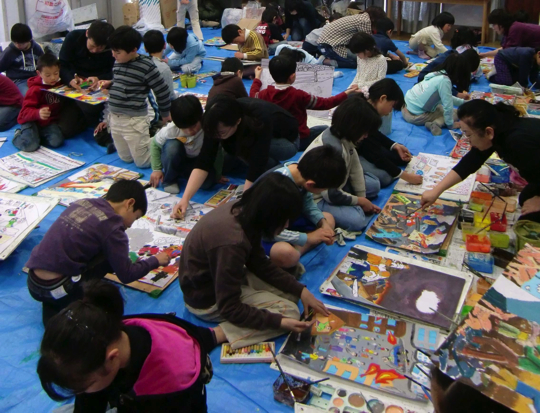 Photo: Scene from a “Disaster drawing” session in which participants create pictures inspired by earthquake footage and firsthand accounts provided by instructors
Photo: Scene from a “Disaster drawing” session in which participants create pictures inspired by earthquake footage and firsthand accounts provided by instructors
There may be no universal agreement on whether or not very young children should watch earthquake footage, but Ms. Nakajima maintains that they should. The point of her “Inochi no Jugyo” is that it teaches children how to harness the fear evoked by such images, and shows what natural disasters are, as well as how one might survive them. It is with determination and conviction that Ms. Nakajima engages with children.
Whether aged 6 or 12, the important thing is for the child to go through torment and serious thinking unique to a child of his or her age in the process of creating the picture. Imagining what it would be like to be in the midst of a disaster makes a difference in the child’s character-building, and affects how he or she seeks safety from, prepares for, and aids others in the event of an earthquake.
“Inochi no Jugyo” is supported by the participants’ parents, as well. People with firsthand experience of disasters invariably have their own dramas to tell. Experiences of family members also inspire the childrens’ pictures. The mother of one of the participants phoned to say that she was grateful for the opportunity of sharing her account of the earthquake with her child. Ms. Nakajima argues that adults should make greater efforts to talk to children about life. She feels that more people should express in words how much they care about parenting, and how deeply they love their children.
Expressing the weight of one’s life through the “Drawing Sunflowers of Life” project
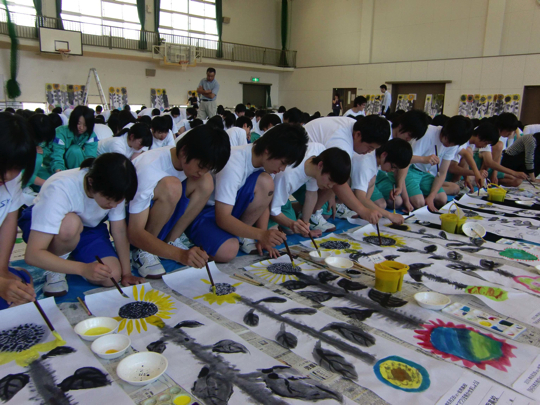
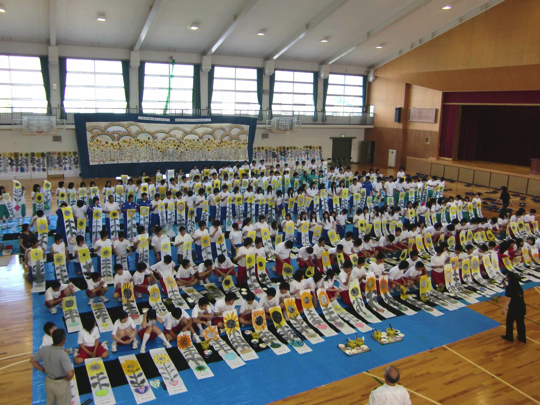 Photo: Scene from the “Drawing Sunflowers of Life” project at Hyogo Prefectural Sayo High School
Photo: Scene from the “Drawing Sunflowers of Life” project at Hyogo Prefectural Sayo High School
Ms. Nakajima’s activities now extend beyond her art classes. In 2008 she began a project called “Drawing 6,434 sunflowers of life for remembering Jan 17.” The project involves inviting children, who represent the future generation, to create 6,434 drawings —one for each life lost to the Great Hanshin-Awaji Earthquake—of sunflowers, the symbol of Kobe’s post-disaster rehabilitation. Children participating in the project are asked to spare thoughts of earthquake victims as they make the pictures.
After giving a talk on the Great Hanshin-Awaji Earthquake, I ask the children to place their hands over their chest, where their heart is. “Close your eyes quietly and listen. Is there more than one heartbeat like yours in this world?” The children think for a moment and then shake their heads, saying, “No, mine’s the only one in the world.”
Their reactions to being made aware of the singular, precious nature of life are expressed in the form of images made by children on washi (Japanese paper). Each bold and powerful image represents the life of the person who made it, a “seed” from which a sunflower emerges to grow and grow into the sky. The children then carefully draw the disc floret bearing the sunflower’s seeds, which carry life into the next generation.
Over a period of three years, the project resulted in 3,420 sunflower drawings at 21 kindergartens, as well as elementary, middle and high schools. The project is currently suspended, however, due to an unforeseen event: the Great East Japan Earthquake, which struck on March 11, 2011.
How should an educator spend March 12, 2011?
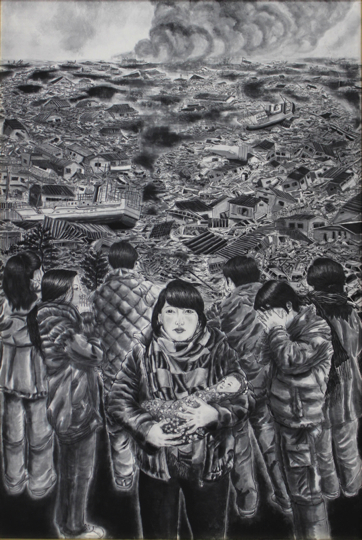 Photo: Wasurenaide (Do not forget), inspired by earthquake- and tsunami-hit Tohoku localities, was painted by Yoko Nakajima, who maintains a productive career as an artist alongside her activities as a children’s art teacher.
Photo: Wasurenaide (Do not forget), inspired by earthquake- and tsunami-hit Tohoku localities, was painted by Yoko Nakajima, who maintains a productive career as an artist alongside her activities as a children’s art teacher.
After spending the entire night of March 11 in tears, troubled by the thought of communities affected by the earthquake and tsunami, Ms. Nakajima became sure that her actions on the day after—March 12—would hold key importance to the guidance she provides as an educator to the children in her art classes.
March 12, 2011 was a Saturday, the day of the week when the largest number of children would attend her class. Ms. Nakajima welcomed her students to the classroom with front-page pictures of the devastation wrought by the earthquake and tsunami posted all over the walls, sourced from every newspaper she could find.
She then asked her class, “Can you carry on art class as usual, when so many people in Tohoku have died?” “No, that’s not humane,” responded some. Many followed by voicing their own views, and an active discussion ensued and continued.
Ms. Nakajima shared her memories of the Great Hanshin-Awaji Earthquake once more with the children, such as how everyone wore dark-colored clothes at the makeshift school set up inside the evacuation center, which made her feel sad. Meanwhile in Tohoku, snow and sleet appeared to be adding to the misery of affected communities. Her students and Ms. Nakajima finally agreed to make a picture of a cherry tree in bloom, to help warm up the hearts of people in Tohoku, and to convey their wishes for an early arrival of spring and hope.
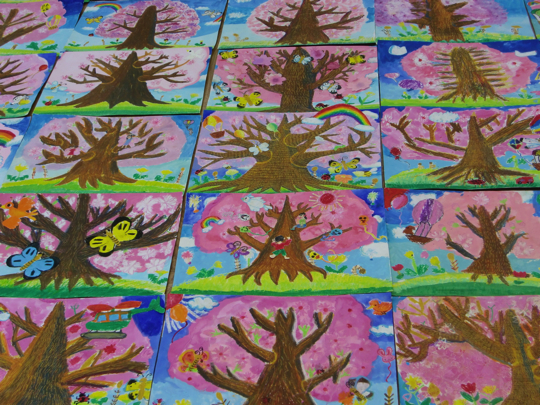 Photo: The “1,000 Cherry Trees of Life” are brimming with the participating children’s goodwill toward disaster-affected communities.
Photo: The “1,000 Cherry Trees of Life” are brimming with the participating children’s goodwill toward disaster-affected communities.
We agreed to draw strong cherry trees impervious to earthquakes or tsunami waves. On the spur of the moment I suggested, “Let’s draw 1,000 of them.” Our art classes have 400 students in all. In addition, I invited students from three schools—Nishinomiya Municipal Koyoen Elementary, Takigawa Boys’ Junior High, and Hyogo Prefectural Sayo High, which had previously hosted the “Inochi no Jugyo” classes—to join the project, and in less than one month, we completed pictures of 1,000 cherry trees.
On April 24, 2011, Ms. Nakajima took the 1,000 cherry blossom pictures to earthquake- and tsunami-hit communities in Tohoku.
People sheltering at evacuation centers were initially reserved. But on learning that I had come all the way from Kobe, their expressions warmed, and they voiced appreciation for the long journey I had made, and for the sympathy from someone who also had firsthand experience of a major quake. When I presented the cherry blossom pictures made by the children, the pictures received a warm round of applause.
Maintaining life means maintaining hope
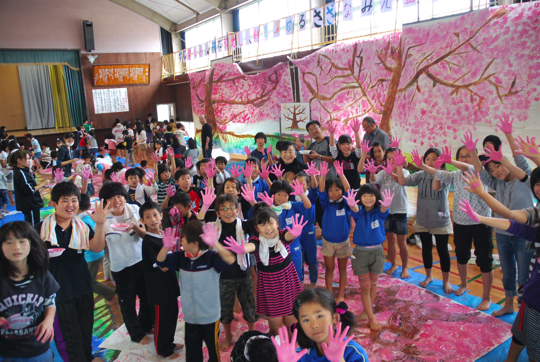 Photo: “Lone Cherry Tree of Life” project at Kesennuma Municipal Hashigami Elementary School. Displayed on the walls are pictures of cherry blossoms made by Kobe children.
Photo: “Lone Cherry Tree of Life” project at Kesennuma Municipal Hashigami Elementary School. Displayed on the walls are pictures of cherry blossoms made by Kobe children.
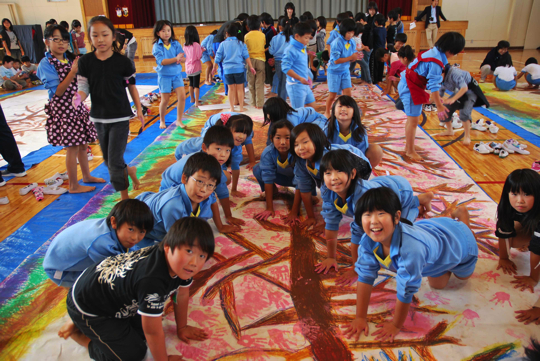 Photo: “Lone Cherry Tree of Life” project at Kesennuma Municipal Omose Elementary School
Photo: “Lone Cherry Tree of Life” project at Kesennuma Municipal Omose Elementary School
Every six months, Ms. Nakajima has visited earthquake-hit Tohoku localities, so far making seven visits. In total she has made 53 elementary and other school visits, involving herself in the emotional care of nearly 3,360 children. She is also involved in ongoing art-mediated support projects for earthquake-affected localities in Hyogo Prefecture, working with some 3,270 children at 27 elementary and other schools.
In partnership with children from Tohoku and Hyogo, Ms. Nakajima is currently working on a project called “Lone Cherry Tree of Life,” which involves picturing a large cherry tree on a wide, 8-meter by 3.2-meter canvas. The cherry tree is brought into full bloom by each participant applying cherry-blossom-colored paint on both palms, and pressing them on the canvas to leave imprints.
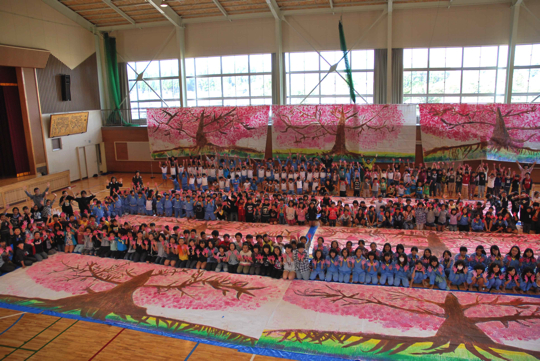 Photo: “Lone Cherry Tree of Life” by 396 pupils from Kesennuma Municipal Omose Elementary School. The pictures show vigorous cherry-tree roots, impervious to earthquakes and tsunami.
Photo: “Lone Cherry Tree of Life” by 396 pupils from Kesennuma Municipal Omose Elementary School. The pictures show vigorous cherry-tree roots, impervious to earthquakes and tsunami.
Ms. Nakajima believes Kobe’s children have the duty to restore Kobe from damage inflicted by the Great Hanshin-Awaji Earthquake, and make Kobe vigorous. She hopes that creating pictures inspired by thoughts on life will foster in children resilience and a sense of appreciation for the very fact that they are alive today.
The Great Hanshin-Awaji Earthquake claimed 6,434 lives; the Great East Japan Earthquake claimed 15,889. Thinking about each and every one of them reminds us that the life we enjoy today should not be taken for granted.
Efforts to communicate earthquake experiences to children must continue, so as to build the future of this country, which will remain ever vulnerable to major earthquakes.
Interviewed and written by Kyoko Sugimoto
This article was created with the cooperation of
greenz.jp.
![]() an artist
an artist JP | EN
JP | EN JP | EN
JP | EN










